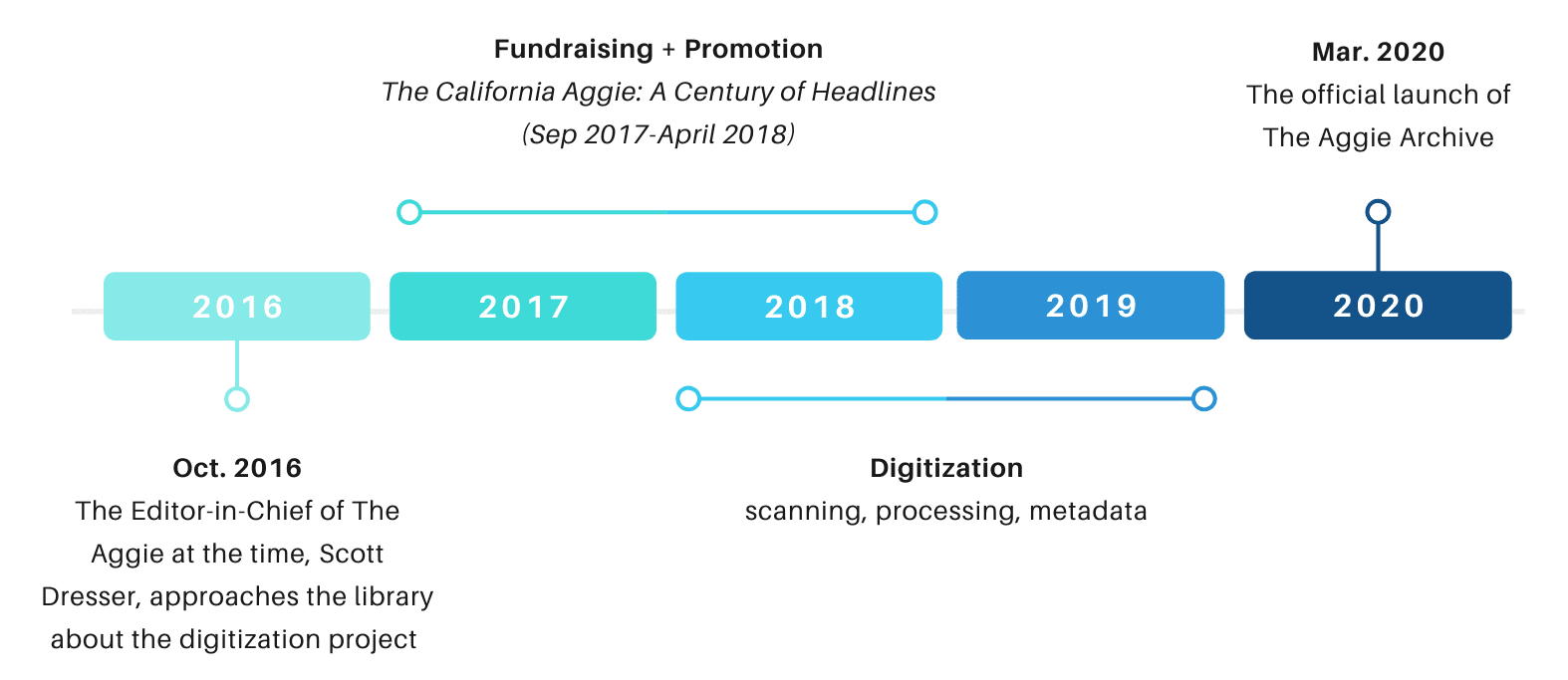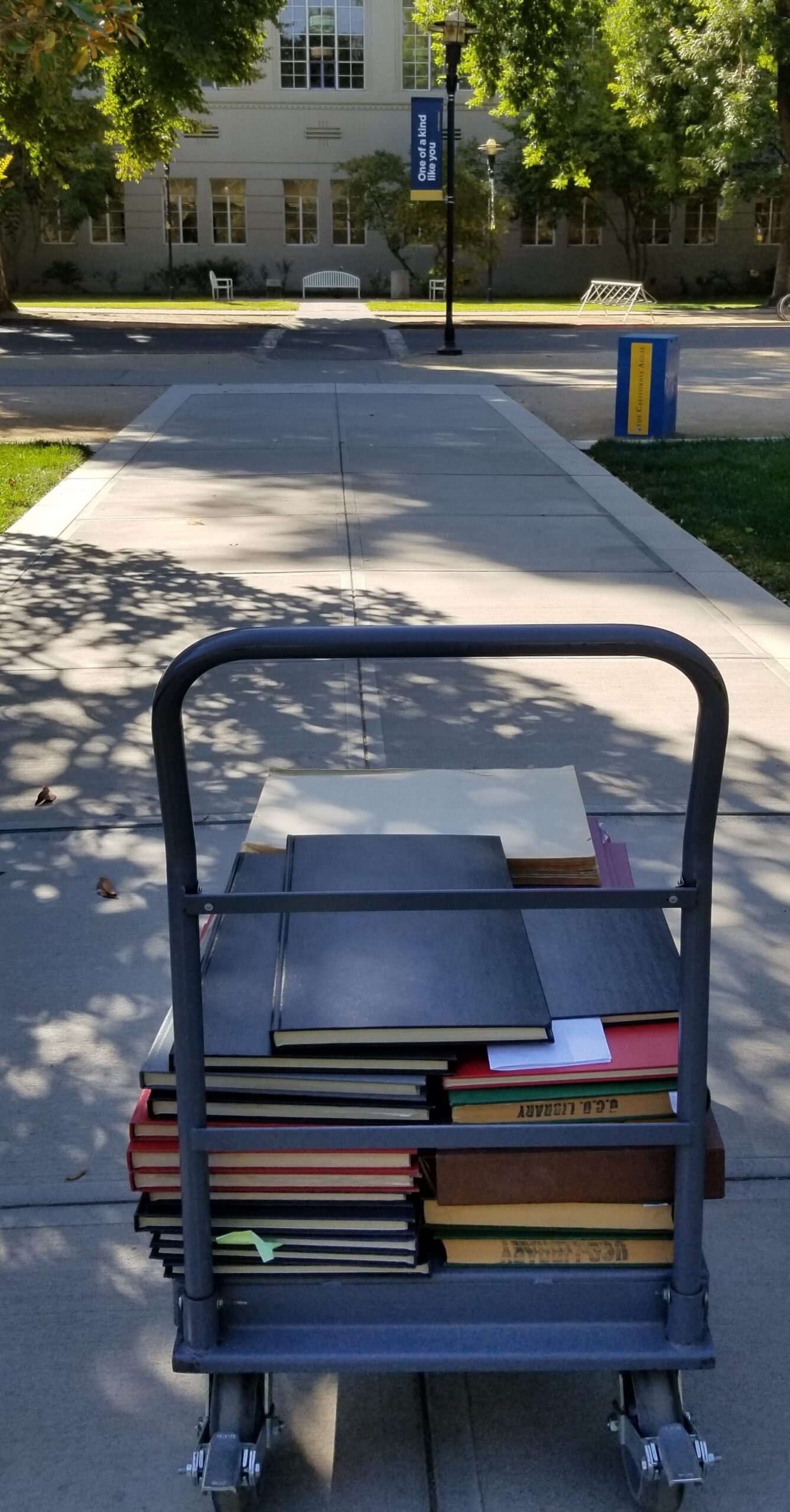Early mastheads (from 1915, 1941 and 1945) illustrate how The California Aggie evolved over time, from one era and editorial staff to the next.
Aggie Archives Go Digital
Partnership between library and campus newspaper opens new window into UC Davis history
This spring, the UC Davis Library and The California Aggie have launched a complete online archive of the campus newspaper going all the way back to its first issue in 1915, when UC Davis was still the University Farm and its newspaper was known as The Weekly Agricola. With 5,410 issues now available online to search, view, print or download, the Aggie is the first undergraduate UC newspaper to digitize its collection.
Partnering with The California Aggie
The project has been four years in the making, starting with an October 2016 meeting between then Editor-in-Chief of the Aggie, Scott Dresser, and Kevin Miller, the library’s university archivist and head of Archives and Special Collections.

Dresser had noticed other student papers attempting to independently digitize their collections without much success and decided to partner with the UC Davis Library. Seeing a unique opportunity to expand access to a significant part of the University Archives, the library was eager to work together, too.
“Copyright in newspapers is really complex because there’s photography, there’s multiple authors, there’s the involvement of ASUCD,” explained Miller. “So just having the newspaper on board from the beginning was really helpful in terms of being able to put this online where it’s openly accessible.”
In the years leading up to the official launch of the archive, the Aggie experienced four successions of Editor-in-Chief.
“Every editor is different and each comes into the job with a different perspective on what they want to do in their leadership role,” said Laurie Pederson, the Business and Advertising Manager for the Aggie since 2017, who has worked with each of the newspaper’s editors throughout the campaign. “The digitization project has been one of the constants in the past several years, and has allowed each one to play a role.”
For one editor-in-chief, that role extended beyond helping to archive the print edition. In 2019, Miller worked with then Editor-in-Chief, Emily Stack, to bring the Aggie’s photo morgue — the photographs and negatives that the paper had produced through the years — over to the library’s University Archives. (Next month, the library will launch an online exhibit featuring some incredible examples of student photojournalism from that archive. Watch for our announcement when the new exhibit goes live!)

Fundraising and Promotion
While the Aggie provided complementary content for the archive, the library took the lead on fundraising and outreach for the project and, later on, managing the logistics of digitization.
During the 2017-18 academic year, Miller curated an exhibit titled “The California Aggie: A Century of Headlines” that featured notable page-one stories from the Aggie through the years.
During the same period, library staff and Aggie editors also ran a campaign table at UC Davis basketball games, culminating in a reception after one of the games. At the event, several Aggie alumni were brought in to support the project.
“Our primary target audience for fundraising were alumni and in particular, there was a real push to try to get former Aggie staffers involved,” said Miller. “People who work for the Aggie often carry that with them throughout their lives. In many cases, it’s what got them started in journalism, sometimes Pulitzer Prize-winning journalism.”
While several donors had contributed by this point, it wasn’t until the final weeks that a major donor stepped forward to provide the remaining funds.
On what reaching the fundraising goal meant to the Aggie, Pederson said, “It proved to us the importance of the Aggie to others on campus. Having the library’s support through it all was a very uplifting feeling for our team.”
From Microfilm to Online Archive
Before the project was underway, the library’s back issues of The California Aggie were archived on microfilm, a reel of film that stores miniature photographic copies of printed materials. The original bound copies were stored in an off-site facility for preservation.

“It’s really only a dedicated researcher and an exceptionally dedicated undergraduate student who’s going to take the time to come to our reading room and order the bound copy ahead of time or go down to the lower level and figure out how to use the microfilm reader,” said Miller.
The goal of the digital archive was, in Miller’s words, to enable anyone interested in UC Davis’ past to “really experience the Aggie in its full historical run” — making it easy to find, search and read each article, advertisement, photo and caption.
Originally, the Library and the Aggie planned to digitize the microfilm archive, but quickly determined that the original print was the best source since many of the photographs on the microfilm were blurry and smudged.
Miller explained, “We want to do it once and we want to do it right, so that we don’t have to do it again.”
The concern raised with using the library’s set of print copies was that, since they were bound, the originals would be damaged if they were to be scanned completely through to the margins.
Through the partnership with the Aggie, a new solution presented itself. The Aggie, too, had a large inventory of bound copies from previous years in their offices in Freeborn Hall. By digitizing copies provided by the Aggie instead, the library was able to preserve the integrity of its archival print collection.
The copies were sent to Backstage Library Works, which is headquartered in Provo, Utah, to be scanned, digitized and labeled for their metadata. In early 2019, after several months of work, the scanning was completed. The materials then made their way to UC Riverside, where the Center for Bibliographical Studies and Research (CBSR) is based. One of the research center’s most substantial projects is the California Digital Newspaper Collection (CDNC), a database of more than a million significant historical California newspapers of which the Aggie is now a part.

On why it is important to preserve the print format of the paper, Pederson said, “Every page is a veritable time capsule, and seeing all the pages in a chronological format that is searchable provides a complete depiction of the times. Unlike just the stories themselves, which only shot a snapshot of information, every page and it’s style, format, content and design truly show the changing times.”
Students, staff and scholars can now view more than a century of UC Davis and local history through an online database that allows users to search by keyword, date, content type and word count. To learn more, read the Aggie’s story about the digital collection.